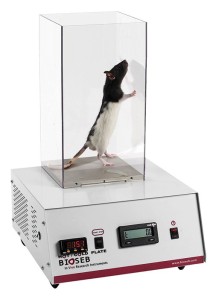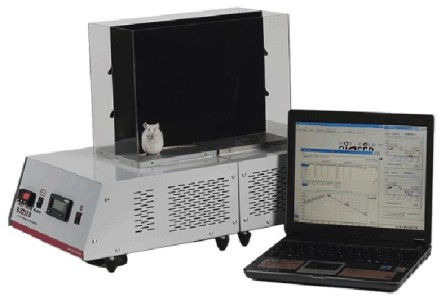Authors
Balayssac D, Ling B, Ferrier J, Pereira B, Eschalier A, Authier N.
Lab
Faculties of Medicine and Pharmacy, Clermont Université, France
Journal
Behav Pharmacol.
Abstract
Thermal sensitivity is an essential characteristic of some painful states, including oxaliplatin-induced neuropathy. The thermal place preference test (TPPT) was designed to finely assess thermal sensitivity in rodents. The TPPT monitors the time spent by unrestrained rodents on a test plate at fixed temperatures (5-50°C) compared with an adjacent reference plate at a neutral temperature (25°C). Here, we report the results of a study designed (i) to validate the optimal methodological parameters for measuring thermal sensitivity in rats, (ii) to assess the thermal sensitivity of healthy rats and animal models of pain and (iii) to explore the pharmacological effects of analgesic drugs. The most reproducible conditions occurred when the TPPT was performed in the morning and in the dark for 3 min with the reference plate set to 25°C. The temperature preferences of healthy rats were more than 17°C and less than 40°C. When compared with control animals, oxaliplatin-treated rats showed thermal hypersensitivity at 12, 20 and 35°C, and carrageenan-treated rats showed thermal hypersensitivity at 15 and 45°C. Duloxetine (2.5 mg/kg, intraperitoneal) reversed oxaliplatin-induced cold hypersensitivity (20°C) and morphine (1 mg/kg, intravenous) reversed carrageenan-induced heat hypersensitivity (45°C). We conclude that the TPPT enables a fine-grained assessment of thermal sensitivity that is relevant to the pathophysiological exploration of animal pain models and to the pharmacological assessment of analgesic drugs.
BIOSEB Instruments Used
Cold Hot Plate Test (BIO-CHP),Thermal Place Preference, 2 Temperatures Choice Nociception Test (BIO-T2CT)
Source :

 Douleur - Allodynie/Hyperalgésie Thermique
Douleur - Allodynie/Hyperalgésie Thermique Douleur - Spontanée - Déficit de Posture
Douleur - Spontanée - Déficit de Posture Douleur - Allodynie/Hyperalgésie Mécanique
Douleur - Allodynie/Hyperalgésie Mécanique Apprentissage/Mémoire - Attention - Addiction
Apprentissage/Mémoire - Attention - Addiction Physiologie & Recherche Respiratoire
Physiologie & Recherche Respiratoire




































 Douleur
Douleur Système Nerveux Central (SNC)
Système Nerveux Central (SNC)  Neurodégénérescence
Neurodégénérescence Système sensoriel
Système sensoriel Système moteur
Système moteur Troubles de l'humeur
Troubles de l'humeur Autres pathologies
Autres pathologies Système musculaire
Système musculaire Articulations
Articulations Métabolisme
Métabolisme Thématiques transversales
Thématiques transversales Congrès & Meetings
Congrès & Meetings 
